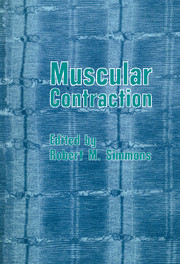Book contents
- Frontmatter
- Contents
- Dedication
- Contributors
- Preface
- 1 A. F. Huxley: an essay on his personality and his work on nerve physiology
- 2 A. F. Huxley's research on muscle
- 3 Ultraslow, slow, intermediate, and fast inactivation of human sodium channels
- 4 The structure of the triad: local stimulation experiments then and now
- 5 The calcium-induced calcium release mechanism in skeletal muscle and its modification by drugs
- 6 Hypodynamic tension changes in the frog heart
- 7 Regulation of contractile proteins in heart muscle
- 8 Differential activation of myofibrils during fatigue in twitch skeletal muscle fibres of the frog
- 9 High-speed digital imaging microscopy of isolated muscle cells
- 10 Inotropic mechanism of myocardium
- 11 Regulation of muscle contraction: dual role of calcium and cross-bridges.
- 12 Fibre types in Xenopus muscle and their functional properties.
- 13 An electron microscopist's role in experiments on isolated muscle fibres.
- 14 Structural changes accompanying mechanical events in muscle contraction.
- 15 Mechano-chemistry of negatively strained cross-bridges in skeletal muscle.
- 16 Force response in steady lengthening of active single muscle fibres.
- References
- Index
3 - Ultraslow, slow, intermediate, and fast inactivation of human sodium channels
Published online by Cambridge University Press: 07 September 2010
- Frontmatter
- Contents
- Dedication
- Contributors
- Preface
- 1 A. F. Huxley: an essay on his personality and his work on nerve physiology
- 2 A. F. Huxley's research on muscle
- 3 Ultraslow, slow, intermediate, and fast inactivation of human sodium channels
- 4 The structure of the triad: local stimulation experiments then and now
- 5 The calcium-induced calcium release mechanism in skeletal muscle and its modification by drugs
- 6 Hypodynamic tension changes in the frog heart
- 7 Regulation of contractile proteins in heart muscle
- 8 Differential activation of myofibrils during fatigue in twitch skeletal muscle fibres of the frog
- 9 High-speed digital imaging microscopy of isolated muscle cells
- 10 Inotropic mechanism of myocardium
- 11 Regulation of muscle contraction: dual role of calcium and cross-bridges.
- 12 Fibre types in Xenopus muscle and their functional properties.
- 13 An electron microscopist's role in experiments on isolated muscle fibres.
- 14 Structural changes accompanying mechanical events in muscle contraction.
- 15 Mechano-chemistry of negatively strained cross-bridges in skeletal muscle.
- 16 Force response in steady lengthening of active single muscle fibres.
- References
- Index
Summary
Introduction (by R. Rüdel)
After Hodgkin and Huxley (1952a,b) had described the currents underlying excitation of the squid axon, many investigators attempted to explore the mechanism of excitation in other cells such as myelinated nerve (Frankenhäuser & Huxley, 1964) and mammalian heart (Noble, 1966). I joined Trautwein's laboratory in 1965, where at the time experiments were carried out with the aim “to clamp the sodium current” in sheep Purkinje fibres (Dudel et al., 1966, Dudel & Rüdel, 1970). During a postdoctoral fellowship in Andrew Huxley's laboratory in 1968-70, I was diverted to the inward spread of activation in skeletal muscle in accordance with Huxley's more recent interests, but, back in Germany, I returned to excitation, this time to disorders of excitation in human muscle, in particular in the myotonias (Rüdel & Lehmann-Horn, 1985) and periodic paralyses (Rüdel & Ricker, 1958)
Inactivation mechanisms
In their first mathematical description of the transient sodium current, lNa(t), through the membrane of excitable cells, Hodgkin and Huxley (1952d; HH) postulated two independent mechanisms for the activation, m, and inactivation, h, of the passage of ions through membranes. The equation lNa(t) = gNa (E –ENa) m3h, with gNa the maximum sodium conductance, and (E - –Na) the difference between the membrane potential and the sodium equilibrium potential, gave good fits to the experimental data, when first-order kinetics were assumed to be valid for the time dependence of m and h. In modern terms, the sodium ions are assumed to pass the membrane through channel proteins which are able to adopt conducting and nonconducting states.
- Type
- Chapter
- Information
- Muscular Contraction , pp. 43 - 52Publisher: Cambridge University PressPrint publication year: 1992
- 1
- Cited by



